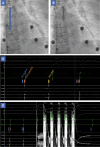Superior vena cava isolation using a pentaspline pulsed-field ablation catheter: feasibility and safety in patients undergoing atrial fibrillation catheter ablation
- PMID: 38875490
- PMCID: PMC11252500
- DOI: 10.1093/europace/euae160
Superior vena cava isolation using a pentaspline pulsed-field ablation catheter: feasibility and safety in patients undergoing atrial fibrillation catheter ablation
Abstract
Aims: Superior vena cava (SVC) isolation during atrial fibrillation catheter ablation is limited by the risk of collateral damage to the sinus node and/or the phrenic nerve. Due to its tissue-specificity, we hypothesized the feasibility and safety of pulsed-field ablation (PFA)-based SVC isolation.
Methods and results: One hundred and five consecutive patients undergoing PFA-based AF catheter ablation were prospectively included. After pulmonary vein isolation (±posterior wall isolation and electrical cardioversion), SVC isolation was performed using a standardized workflow. Acute SVC isolation was achieved in 105/105 (100%) patients after 6 ± 1 applications. Transient phrenic nerve stunning occurred in 67/105 (64%) patients but without phrenic nerve palsy at the end of the procedure and at hospital discharge. Transient high-degree sinus node dysfunction occurred in 5/105 (4.7%) patients, with no recurrence at the end of the procedure and until discharge. At the 3-month follow-up visit, no complication occurred.
Conclusion: SVC isolation using a pentaspline PFA catheter is feasible and safe.
Keywords: Atrial fibrillation; Catheter ablation; Feasibility; Outcome; Pulsed-field ablation; Superior vena cava.
© The Author(s) 2024. Published by Oxford University Press on behalf of the European Society of Cardiology.
Conflict of interest statement
Conflict of interest: P.O. received consulting fees from Abbott, Biotronik, Boston Scientific, and Medtronic. M.M. received speaker fees/honoraria from Abbott, Bayer Healthcare, Biosense Webster, Biotronik, Amomed, AOP Orphan, Boston Scientific, Daiichi Sankyo, and BMS/Pfizer and research grants from Biosense Webster and Abbott. S.C. received consulting fees/honoraria from Abbott and Boston Scientific. P.M. received consulting fees from Biotronik and Boston Scientific. L.C.-R. received consulting fees from Boston Scientific, Medtronic, and Microport CRM. F.A. received consulting fees and speaker honoraria from Microport CRM, Boston Scientific, and Medtronic.
Figures




Comment in
-
Quest for safe and feasible isolation of superior vena cava by pulsed-field ablation: are we there yet?Europace. 2024 Jul 2;26(7):euae159. doi: 10.1093/europace/euae159. Europace. 2024. PMID: 38874397 Free PMC article.
References
-
- Davong B, Adelino R, Delasnerie H, Albenque JP, Combes N, Cardin C et al. Pulsed-field ablation on mitral isthmus in persistent atrial fibrillation. Preliminary data on efficacy and safety. JACC Clin Electrophysiol 2023;9:1070–81. - PubMed
-
- Tsai CF, Tai CT, Hsieh MH, Lin WS, Yu WC, Ueng KC et al. Initiation of atrial fibrillation by ectopic beats originating from the superior vena cava. Electrophysiological characteristics and results of radiofrequency ablation. Circulation 2000;102:67–74. - PubMed
MeSH terms
LinkOut - more resources
Full Text Sources
Medical

